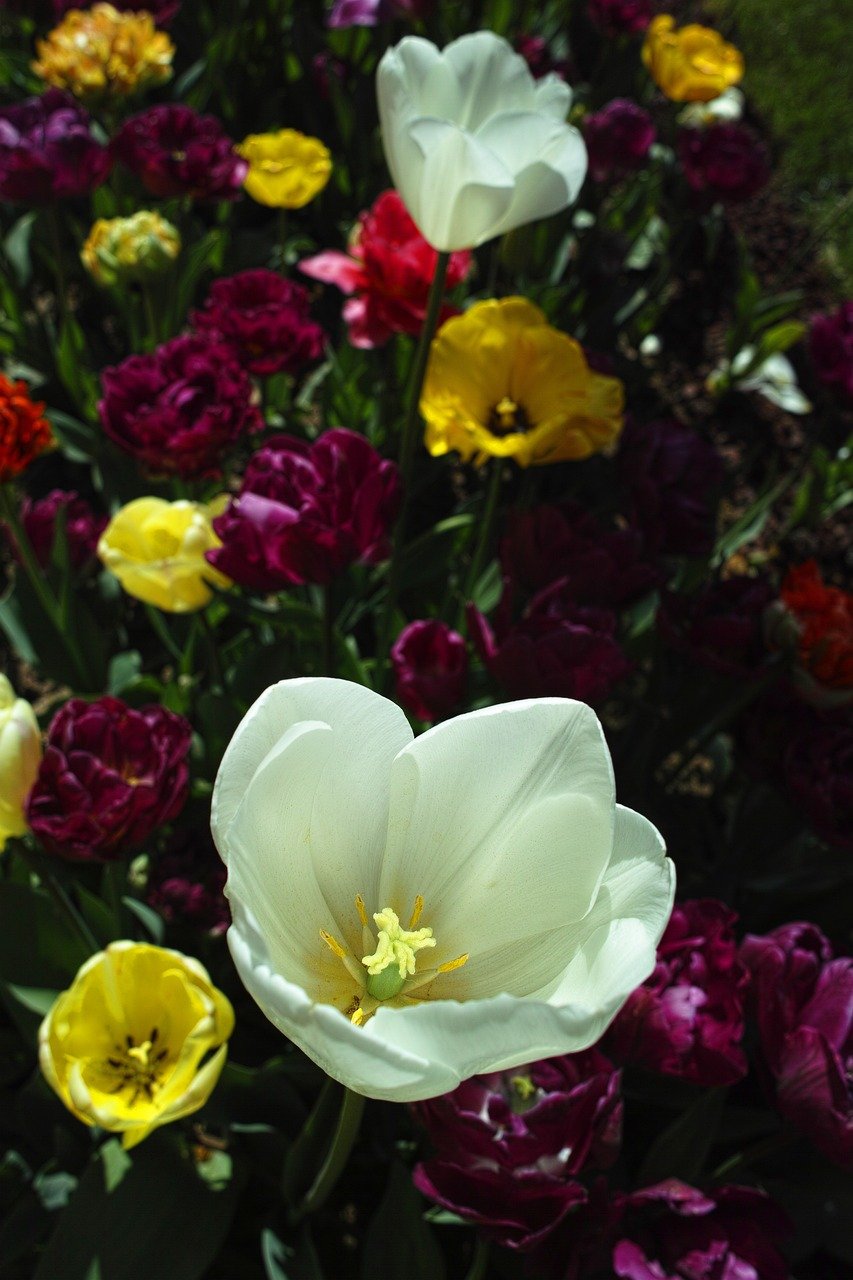
Are you a plant lover looking to maximize your space and add a touch of greenery to your home? Look no further! In this article, we will explore some innovative and imaginative methods to create your very own vertical herb garden. Embracing the concept of vertical gardening, these creative ideas will not only save you space but also bring a burst of fresh flavors to your culinary adventures. Get ready to turn your empty walls and tight corners into thriving herb havens, effortlessly infusing your living space with nature’s beauty and delightful aromas. So, roll up your sleeves and let’s get started on this green journey together!

Choosing the Right Location
Indoor vs. Outdoor
When deciding to create a vertical herb garden, one of the first considerations you must make is whether you will be growing your herbs indoors or outdoors. Both options have their benefits, so it ultimately depends on your individual preferences and circumstances.
Growing herbs indoors can be a great option if you have limited outdoor space or if you live in an area with harsh weather conditions. Indoor gardens allow you to have fresh herbs year-round, regardless of the season. They also provide the added advantage of being easily accessible from your kitchen, making it convenient to snip off some fresh herbs while you cook.
On the other hand, outdoor gardens can offer a wider variety of herbs to grow and provide the opportunity for your plants to receive natural sunlight, which is essential for their growth. If you have a sunny spot in your garden, consider creating your vertical herb garden there. The abundant sunlight will promote healthy growth and vibrant flavors in your herbs.
Sunlight Requirements
When selecting the location for your vertical herb garden, it’s important to consider the sunlight requirements of the herbs you wish to grow. Most herbs thrive in full sun, which is typically defined as six or more hours of direct sunlight per day. However, some herbs, such as parsley, cilantro, and mint, can tolerate partial shade.
Before planting your herbs, observe the amount of sunlight your chosen location receives throughout the day. This will help you determine which herbs are suitable for that spot. If your vertical garden is located indoors, you may need to supplement the natural light with artificial lighting, such as grow lights, to ensure your herbs receive adequate light for optimal growth.
Accessibility
Another crucial factor to consider when choosing the location for your vertical herb garden is accessibility. You’ll want to place your herbs in a spot that is easily reachable so that you can tend to them, harvest their leaves, and water them without trouble.
If you’re creating an indoor vertical herb garden, consider situating it near your kitchen or in a room where you spend a lot of time. This way, you’ll have easy access to the herbs when you need them for cooking or adding a fresh touch to your dishes.
For outdoor gardens, aim to position your vertical herb garden in a spot that is convenient to access. Avoid areas that are difficult to reach or require climbing, as this can be challenging when it comes to regular maintenance, harvesting, and pruning. A location near your outdoor seating area or close to your kitchen door can be ideal for easy accessibility.
Selecting the Perfect Herbs
Consider Your Preferences
When it comes to selecting the herbs for your vertical garden, it’s essential to consider your personal preferences. Think about the herbs you love to cook with or the flavors that appeal to you the most. By choosing herbs you enjoy, you’ll be more motivated to care for them and make them a regular part of your culinary adventures.
Classic culinary herbs like basil, rosemary, thyme, and oregano are popular choices for any herb garden. They add depth and aroma to various dishes, making them versatile and enjoyable to have on hand. However, don’t be afraid to experiment with less common herbs that pique your interest, such as lemon verbena, pineapple sage, or chocolate mint.
Consider Herbs That Thrive Vertically
To make the most of your vertical herb garden, consider selecting herbs that thrive in a vertical growing environment. These herbs are well-suited for containers with limited horizontal space and can tolerate being grown in a more upward fashion.
Some herbs that are particularly well-suited for vertical gardening include mint, thyme, sage, and rosemary. Their compact growth habits and ability to withstand occasional pruning make them great choices for vertical planters or hanging containers. Additionally, herbs like chives and parsley can also be grown vertically and add a touch of elegance to your herb garden.
Mix Up the Selection
When choosing herbs for your vertical garden, don’t limit yourself to just one or two varieties. Mixing up the selection of herbs can not only create a visually appealing display but also provide you with a diverse range of flavors and aromas to enhance your culinary creations.
Consider including a mix of different herb types, such as aromatic herbs like lavender and lemon balm, culinary herbs like basil and cilantro, and medicinal herbs like chamomile and peppermint. A varied herb garden will not only offer an array of sensory experiences but also provide you with a well-rounded selection of herbs to meet all your cooking and wellness needs.

Creative Containers for Your Herb Garden
Hanging Shoe Organizer
If you’re looking for an inexpensive and space-saving solution for your vertical herb garden, a hanging shoe organizer can be a fantastic option. This creative container allows you to utilize wall space while keeping your herbs easily accessible.
To make a hanging shoe organizer herb garden, simply hang the organizer on a sturdy hook or rod and fill each pocket with soil and your chosen herbs. Ensure that the pockets have sufficient drainage holes to prevent waterlogging and be mindful of watering frequency, as the pockets may dry out more quickly than traditional pots or planters.
This DIY vertical herb garden is not only practical but also adds a unique and decorative touch to your living space, making it a conversation starter among guests.
Pallet Herb Wall
Repurposing a wooden pallet as a vertical herb garden is an excellent way to give your outdoor space a rustic and charming appeal. It also allows you to maximize your herb-growing potential in a small area.
Start by securing the pallet to a vertical surface, such as a wall or fence, and fill the gaps between the slats with landscape fabric or weed barrier. Then, add potting soil or a soil mixture suitable for herbs into each of the compartments created by the slats.
Once your pallet is set up, you can easily plant your chosen herbs into each compartment. The pallet herb wall provides ample space for a variety of herbs, allowing you to create a lush and vibrant garden that is both functional and visually pleasing.
Vertical Bamboo Planter
For a more eco-friendly option with an exotic touch, consider creating a vertical bamboo planter for your herb garden. Bamboo is a sustainable material that adds a natural aesthetic to any space.
To make a vertical bamboo planter, gather several bamboo poles of the same length and diameter and secure them together using sturdy twine or zip ties. Arrange the poles in a vertical fashion, with the twine or zip ties creating individual compartments for planting.
Once the structure is in place, fill each compartment with a suitable potting mix and plant your desired herbs. The vertical bamboo planter not only provides ample growing space but also adds a touch of elegance and tropical charm to your herb garden.
Utilizing Wall Space
Vertical Wall Pockets
Wall pockets are an excellent option for utilizing wall space and creating a striking vertical herb garden. These pockets, usually made of felt or fabric, can be attached to interior or exterior walls, allowing you to grow herbs in a unique and space-saving manner.
To create a vertical herb garden using wall pockets, affix the pockets securely to the wall, ensuring they are level and stable. Fill each pocket with well-draining soil and plant your chosen herbs. Be sure to water the herbs adequately, as the pockets may dry out more quickly than traditional containers.
Vertical wall pockets not only provide a visually appealing display but also make it easy to access and care for your herbs. Their compact design is especially beneficial for those with limited floor space or who want to add a touch of greenery to their walls.
Magnetic Herb Jars
If you’re short on space but still want to enjoy the benefits of fresh herbs, magnetic herb jars can be an ideal solution. These jars easily adhere to any magnetic surface, such as the side of a refrigerator or a metal backsplash, allowing you to create a vertical herb garden right in your kitchen.
To use magnetic herb jars, simply fill each jar with soil and plant your chosen herb seeds or seedlings. Attach the jars to a clean, dry magnetic surface, ensuring they are secure and stable. It’s important to use lightweight jars to prevent any damage to the surface or potential accidents.
Magnetic herb jars not only add a functional and space-saving element to your kitchen but also create a visually interesting and vibrant display. You’ll have easy access to fresh herbs while cooking, making it convenient and enjoyable to incorporate them into your culinary masterpieces.
Picture Frame Herb Garden
For a unique and visually appealing way to utilize wall space, consider creating a picture frame herb garden. This DIY project allows you to transform an ordinary picture frame into a vertical garden that can be displayed indoors or outdoors.
To make a picture frame herb garden, start by removing the glass and backing from a suitable-sized picture frame. Attach a piece of wire mesh or chicken wire to the back of the frame, creating compartments for planting. Fill each compartment with soil and plant your chosen herbs.
Hang the frame securely on a wall or use it as a freestanding structure. Watch as your herbs grow and tumble down the frame, creating a beautiful and aromatic display. The picture frame herb garden is not only functional but also adds a touch of artistry to your living space.

Going Up with Shelving
Floating Shelves
Floating shelves are an excellent choice for creating a vertical herb garden while adding a touch of modern elegance to your decor. These shelves appear to “float” on the wall and provide ample space for housing your favorite herbs.
To set up a vertical herb garden using floating shelves, determine the desired height and spacing between shelves, taking into account the growth requirements of your herbs. Install the brackets or supports according to the manufacturer’s instructions, ensuring they are secure and level.
Once the shelves are in place, decorate them with attractive pots or planters filled with your chosen herbs. Consider grouping herbs with similar growing conditions on the same shelf to make maintenance and care more efficient.
Floating shelves not only provide a practical and space-efficient way to grow herbs but also allow you to showcase your green thumb and create an eye-catching display that complements your home decor.
Ladder Herb Garden
Repurposing an old ladder is a creative way to add verticality to your herb garden while embracing a rustic and vintage charm. The rungs of a ladder provide ample space for housing a variety of herbs, making it a unique and functional display.
To create a ladder herb garden, secure the ladder in a stable vertical position, ensuring it is balanced and secure. If necessary, reinforce any weak spots and apply a protective finish to prevent weathering.
Once the ladder is set up, place attractive pots or planters on each rung, ensuring they are stable and level. Fill the pots with appropriate potting soil and plant your chosen herbs.
The ladder herb garden adds an interesting focal point to any outdoor space, transforming an old object into a functional and visually appealing piece of garden art.
Trellis Display
A trellis provides a vertical structure that is perfect for a sprawling herb like chives, making it an excellent choice for creating a vertical herb garden. The trellis not only adds height and dimension to your garden but also creates a visually pleasing backdrop for other herbs.
To create a trellis herb garden, install a trellis securely in your garden or large container, ensuring it is stable and able to support the weight of the plants. Plant chive seedlings or established plants at the base of the trellis, ensuring they have room to climb and grow.
As the chives grow, guide their growth along the trellis using twine or plant ties. Enjoy watching their long, slender leaves cascade down the trellis, creating a captivating and fragrant display.
The trellis herb garden is not only functional but also adds an element of vertical beauty to your outdoor space.
Using Repurposed Items
Old Ladder
Repurposing an old ladder for your vertical herb garden not only gives new life to a discarded item but also adds a unique and rustic charm to your garden. An old ladder can be transformed into a functional and visually pleasing display for your beloved herbs.
To repurpose an old ladder, ensure it is structurally sound and stable. Clean and sand the ladder to remove any loose paint or rough edges. You may choose to apply a protective coat of paint or sealant to enhance its appearance and extend its lifespan.
Once the ladder is prepared, arrange pots or planters on each step of the ladder, ensuring they are stable and level. Fill the containers with high-quality potting soil and plant your chosen herbs.
The old ladder herb garden provides a whimsical and nostalgic touch to your outdoor space, creating a conversation starter and a source of fresh culinary inspiration.
Wooden Pallet
Wooden pallets are versatile and readily available, making them an excellent choice for repurposing into a vertical herb garden. With a bit of creativity and a few simple modifications, a wooden pallet can be transformed into a charming and functional herb-growing structure.
To repurpose a wooden pallet, clean it thoroughly and remove any loose or damaged boards. Sand the surface to create a smooth texture and avoid any potential splinters. Consider applying a protective coating or paint to enhance its appearance and protect it from the elements if using it outdoors.
Once the pallet is prepared, stand it upright against a wall or fence, ensuring it is stable and secure. Fill the gaps between the slats with landscape fabric or weed barrier, and then add potting soil or a suitable soil mixture for herbs.
Plant your chosen herbs in the prepared compartments, ensuring they have enough space and proper drainage. Allow the plants to establish themselves, and soon you’ll have a vibrant and productive herb garden flourishing in your wooden pallet.
Tin Cans
Tin cans are an excellent choice for repurposing into small herb planters, offering a cost-effective and eco-friendly solution for creating a vertical herb garden. With a little creativity and imagination, you can transform ordinary tin cans into unique and charming planters.
To repurpose tin cans, thoroughly clean and remove any labels or adhesives. Consider painting or decorating the cans to add a personal touch and enhance their appearance. Ensure that each can has adequate drainage by punching or drilling several small holes in the bottom.
Once the cans are prepared, fill them with a suitable potting mix and plant your chosen herbs. Attach the cans securely to a wall, fence, or wooden pallet using strong adhesive, hooks, or screws.
The tin can herb planters not only provide a practical and space-saving way to grow herbs but also add a touch of whimsy and creativity to your vertical garden.
DIY Vertical Garden Systems
Stackable Planters
Stackable planters are a versatile and efficient option for creating a vertical herb garden. These systems allow you to maximize space while providing a visually appealing display for your herbs.
To set up a stackable planter system, assemble the individual layers, ensuring they fit securely and are stable. Fill each planter with a suitable potting mix and plant your chosen herbs, making sure they have enough space to grow.
Stack the planters in a stable and secure manner, ensuring each layer is properly aligned. Water the herbs regularly and be mindful of their watering needs, as the top layers may dry out more quickly than the bottom layers.
Stackable planters provide the flexibility to expand or adjust your vertical herb garden according to your needs. They are easy to set up and maintain, offering a practical and space-efficient growing solution.
Cinder Block Herb Wall
A cinder block herb wall is a sturdy and durable option for creating a vertical herb garden with an industrial aesthetic. This DIY project allows you to repurpose cinder blocks into functional planters that can withstand the test of time.
To create a cinder block herb wall, arrange cinder blocks in a vertical position, spacing them evenly and ensuring they are stable and level. Fill each compartment of the cinder blocks with a suitable potting mix and plant your chosen herbs.
As the herbs grow, they will cascade down the sides of the cinder blocks, creating a visually striking and productive herb wall. The cinder block herb wall provides ample growing space and can be easily customized to fit your available space and aesthetic preferences.
PVC Pipe Tower
A PVC pipe tower is a simple and effective way to create a vertical herb garden with a modern and minimalist design. This DIY project allows you to customize the number and size of the planting holes, making it suitable for various herb types.
To create a PVC pipe tower, cut PVC pipes into desired lengths, ensuring they are long enough to accommodate the root systems of your herbs. Drill holes evenly throughout the pipes, leaving enough space between each hole for proper growth and air circulation.
Once the pipes are prepared, stack them vertically, ensuring they are stable and secure. Fill each hole with a suitable potting mix and plant your chosen herbs. Water the plants thoroughly and monitor their moisture levels to ensure they receive adequate irrigation.
The PVC pipe tower provides a space-saving and efficient way to grow herbs vertically. It can be easily assembled and disassembled, making it convenient for those who need flexibility in their gardening arrangements.
Adding a Touch of Artistry
Living Wall Art
Living wall art is a captivating and visually stunning way to incorporate a vertical herb garden into your living space. These living artworks are created using an array of different herbs, plants, and mosses, resulting in a masterpiece that doubles as a functional herb garden.
To create living wall art, start by selecting a suitable frame or structure that can be securely hung on your wall. Line the frame with landscape fabric or a breathable material to hold the soil and prevent it from falling out.
Arrange a variety of herbs in the frame, incorporating different colors, textures, and growth habits for a visually appealing display. Trim and maintain the herbs as they grow, ensuring they fit within the frame and maintain their shape.
The living wall art not only adds a touch of artistry and beauty to your living space but also serves as a source of fresh herbs for culinary delights and home remedies.
Vertical Herb Spiral
A vertical herb spiral is a visually striking and space-saving way to grow herbs while adding an artistic focal point to your garden. This spiral design allows you to grow a variety of herbs in a compact and visually appealing arrangement.
To create a vertical herb spiral, start by marking out a circular or spiral-shaped area in your garden. Build up the walls of the spiral using bricks, stones, or other suitable materials, ensuring each layer is stable and level.
Fill the spiral with a well-draining soil mixture and plant your chosen herbs, taking into consideration their growth habits and their compatibility with one another. Position herbs with similar water and sunlight requirements together for easier care and maintenance.
The vertical herb spiral not only saves space but also provides a dynamic and eye-catching feature that can be admired from any angle. It creates microclimates within the spiral, allowing you to grow herbs with different needs in close proximity.
Herb Wreath
An herb wreath is a charming and whimsical way to add a touch of artistry to your vertical herb garden. This living wreath not only acts as a pleasing decoration but also provides you with a readily available source of fresh herbs for your culinary creations.
To create an herb wreath, start by selecting a suitable base, such as a wire wreath frame or grapevine wreath. Attach bundles of fresh herbs, such as rosemary, thyme, oregano, and lavender, to the base using floral wire or twine. Be creative with the placement and arrangement of the herbs to achieve a visually appealing design.
Hang the herb wreath in a well-ventilated area, such as your kitchen or outdoor patio, ensuring it receives adequate sunlight and airflow. Regularly mist the wreath with water to keep the herbs fresh and fragrant.
The herb wreath not only adds a touch of artistry and aroma to your living space but also offers a convenient and readily accessible source of fresh culinary herbs.
Vertical Gardens for Small Spaces
Window Boxes
Window boxes are a classic and versatile option for creating a vertical herb garden, especially if you have limited outdoor space. These shallow containers can be easily attached to the exterior or interior of windows, allowing you to grow herbs in a visually pleasing and space-efficient manner.
To set up a vertical herb garden using window boxes, choose boxes that are suitable for herb cultivation and can be securely attached. Ensure that each box has adequate drainage holes to prevent waterlogging.
Fill the window boxes with a well-draining potting mix and plant your chosen herbs, ensuring they have enough space to grow. Remember to water the herbs regularly and check the moisture levels, as window boxes can dry out more quickly than traditional gardens.
Window boxes not only provide a charming and decorative element to your home but also bring fresh herbs within arm’s reach, making it convenient and enjoyable to incorporate them into your cooking and everyday life.
Vertical Hanging Pots
Vertical hanging pots are a creative and space-saving solution for creating a vertical herb garden in small spaces. These hanging containers can be suspended from sturdy rods, hooks, or frames, allowing you to maximize your growing potential in even the tightest of spaces.
To set up a vertical herb garden using hanging pots, select pots that are suitable for vertical gardening and have adequate drainage holes. Attach the pots securely to a hanging structure, ensuring they are level and stable.
Fill each hanging pot with well-draining soil and plant your chosen herbs, making sure they have enough space to thrive. Water the herbs thoroughly, taking care not to overwater or allow the pots to become waterlogged.
Vertical hanging pots not only add a touch of greenery to your small space but also provide a functional and visually appealing way to grow herbs where space is at a premium.
Tiered Herb Stand
A tiered herb stand is a practical and visually appealing option for creating a vertical herb garden in a small space. This compact and versatile structure allows you to grow multiple herbs in a tiered arrangement, making the most of the vertical space available.
To set up a tiered herb stand, choose a stand with multiple tiers or levels, ensuring it is sturdy and stable. Place attractive pots or planters on each tier, ensuring they are level and stable. Fill the containers with well-draining soil and plant your chosen herbs.
Position the tiered herb stand in a sunny location, ensuring the herbs receive adequate sunlight for optimal growth. Water the herbs regularly and monitor their moisture levels to prevent drought or waterlogging.
The tiered herb stand not only provides a space-saving solution for small gardens but also allows you to create a visually appealing and productive herb display that adds vitality and flavor to your cooking.
Maintenance Tips for Vertical Herb Gardens
Watering Techniques
Proper watering is essential for the health and vitality of your vertical herb garden. Due to their vertical orientation, vertical gardens may require more attention when it comes to watering, as water may not distribute evenly throughout the containers or planting areas.
When watering your vertical herb garden, be mindful of the specific needs of each herb. Some herbs prefer their soil to dry out slightly between watering, while others require consistently moist soil. Take note of the moisture levels and water your herbs accordingly, adjusting as needed.
To water your vertical herb garden, use a gentle and slow stream of water to prevent soil erosion or damage to delicate herbs. Direct the water at the base of the plants or containers, allowing it to soak into the soil gradually.
Consider installing a drip irrigation system or using self-watering containers to ensure consistent and efficient watering. These systems can help maintain optimal moisture levels and reduce the risk of over or under-watering.
Fertilizing Routine
To ensure that your herbs receive the nutrients they need for healthy growth and abundant harvests, establish a regular fertilizing routine for your vertical herb garden. Fertilizers provide essential minerals and trace elements that can enhance the flavor and aroma of your herbs.
When selecting a fertilizer, choose one that is suitable for herbs and contains balanced nutrients. Organic or slow-release fertilizers are often recommended for herb gardening, as they provide a gradual and sustained release of nutrients.
Follow the manufacturer’s instructions for application rates and timing, as different fertilizers may require different schedules. Be cautious not to over-fertilize, as this can lead to nutrient imbalances or damage to the herbs.
Regularly monitor the growth and health of your herbs, adjusting your fertilizing routine as necessary. With proper fertilization, your vertical herb garden will thrive and provide you with a bountiful and flavorful herb harvest.
Pruning and Harvesting
Pruning and harvesting are essential tasks in maintaining a healthy and productive vertical herb garden. Regular pruning helps promote bushier growth, prevent legginess, and keep the plants in a compact and manageable form.
To prune your herbs, use clean and sharp gardening shears or scissors. Remove any dead or diseased leaves, as well as stems that are overcrowded or growing in an undesirable direction. Consider regularly harvesting the mature leaves to encourage new growth and prolong the herb’s productivity.
When harvesting your herbs, choose the time of day when the flavors are most potent, usually in the morning after the dew has dried. Harvest leaves by cutting them close to the stem, ensuring you do not remove more than a third of the plant’s foliage at once.
Proper pruning and harvesting techniques not only maintain the health and appearance of your vertical herb garden but also ensure you have a constant supply of fresh and flavorful herbs for your culinary endeavors.
In conclusion, creating a vertical herb garden offers a plethora of benefits, regardless of the space you have available. By choosing the right location and considering factors such as sunlight requirements and accessibility, you can create an ideal environment for your herbs to thrive. Selecting a variety of herbs and using creative containers, utilizing wall space, and going up with shelving allows you to maximize your growing potential. Repurposing items and implementing DIY vertical garden systems offer cost-effective and eco-friendly solutions. Adding a touch of artistry enhances the aesthetic appeal of your vertical garden. Finally, proper maintenance, including watering, fertilizing, pruning, and harvesting, ensures that your vertical herb garden remains healthy, productive, and a source of fresh and flavorful herbs for your culinary adventures. With these comprehensive tips and ideas, you’re well on your way to creating a beautiful and thriving vertical herb garden that will bring joy, flavor, and freshness to your life.





